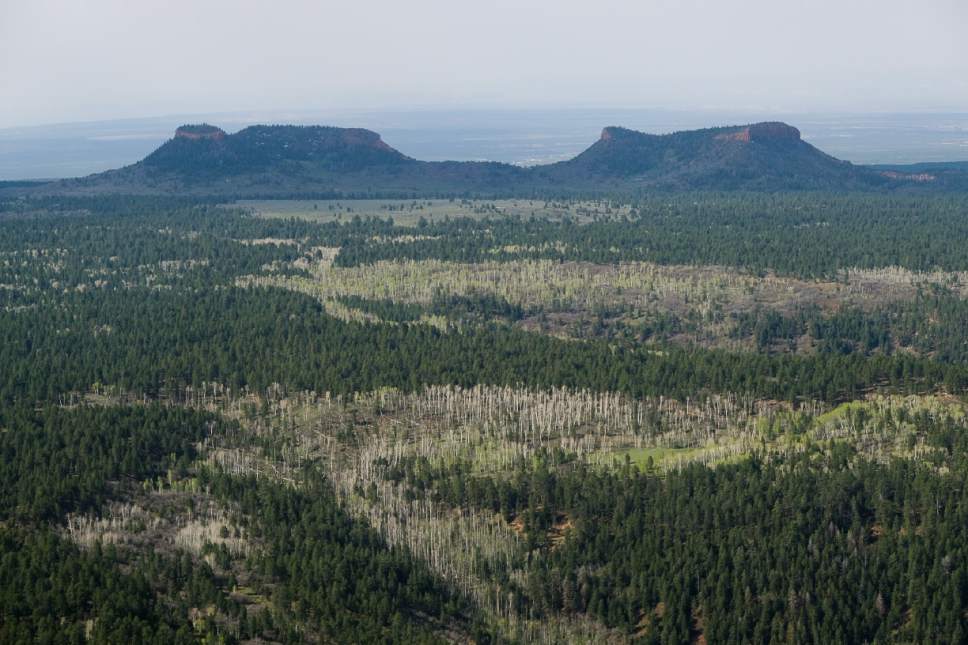This is an archived article that was published on sltrib.com in 2017, and information in the article may be outdated. It is provided only for personal research purposes and may not be reprinted.
Utah's senators are not seeing eye to eye on what steps President Donald Trump should take when it comes to Bears Ears National Monument.
While Sen. Mike Lee is pushing hard for fully rescinding the entire monument, Sen. Orrin Hatch is taking a different approach, pushing the White House to dramatically shrink it, but leave a piece or pieces of the monument preserved, according to interviews with a half-dozen sources familiar with the behind-the-scenes lobbying effort.
Lee believes that rescinding the monument would force members of the conservation community to come to the table and discuss a broader overhaul of the Antiquities Act — the 1906 law that gave the president powers to create monuments to protect archaeological treasures.
Lee has not been shy about his opinion that the power has been abused, with presidents tying up sprawling expanses of federal land, culminating in President Obama's creation of Bears Ears National Monument in December.
Hatch, meanwhile, is pressing for the White House to shrink the monument but leave some of it in place, believing Trump is unlikely to expend the political capital to rescind the monument and that shrinking the monument may be more defensible in court, sources said.
In a way, the disagreement goes to how the senators balance their wishes with the real-world political realities in Washington.
Hatch's spokesman, Matt Whitlock, said in a statement that the senator's priority is ensuring that Utahns and residents of San Juan County get a voice in the protection and in the management of the land.
"In meetings and conversations with [Interior] Secretary [Ryan] Zinke, Senator Hatch has recommended a full recision but will accept whatever the secretary recommends to the President at the end of a fair and thorough review process," Whitlock said.
Lee, in a statement, said he backs eliminating the monument entirely.
"Any movement away from the current designation and towards something that better helps the residents of San Juan County would be welcome," he said, "but I do think a full rescision of the monument puts local, state, and federal communities in the best possible position to find a balanced legislative compromise for the public lands in southeast Utah."
All of this wrangling comes at the expense of any real action as the yearslong failure by leaders in Washington and Utah to protect the treasures in the Bears Ears region essentially forced Obama to designate the area a monument.
Now the Interior Department is taking public input through the end of the week on what should be done with the monument. You can submit a comment at http://www.regulation.gov. Those comments are overwhelmingly in favor of protecting the monument — although that is likely irrelevant. Zinke will make a recommendation to the president in early June, and Trump will decide what action to take.
Energy and Environment News quoted San Juan County Commissioner Phil Lyman in a story Monday, saying that Zinke told him that his inclination was to wipe out the entire monument.
"[Zinke] said, 'Well, let me tell you what I'm thinking: Not only should that monument be rescinded, but we're not going to stop there. We need to discuss all the dysfunctionality of public land management over the last three decades,'" Lyman told E&E News, although he told KSL on Tuesday that he was misquoted.
Those interviewed by The Salt Lake Tribune, who spoke on condition of anonymity because the behind-the-scenes negotiations are ongoing, don't see full monument recision happening. But they agree on one point: Bears Ears will not survive in its current state, and Grand Staircase-Escalante National Monument could also be revised.
The most likely outcome, sources said, is that Trump will likely dramatically shrink the Bears Ears monument, down to two and possibly three parcels totaling fewer — possibly much fewer — than 150,000 acres.
The change would wipe out the monument designation for roughly 90 percent of the landscape. Maps are in the process of being refined in an indication that some portion of the monument will likely survive.
Meanwhile, Rep. Rob Bishop said he is reworking the Public Lands Initiative — rebranding it as PLI 2.0 — to make sure counties' concerns are addressed or, if they can't be addressed, their portions are dropped from the bill. Bishop said he hopes to have the bill introduced and heard in the House this year.
The original PLI, sponsored by Bishop and Rep. Jason Chaffetz, would have created a national conservation area over the Bears Ears and Cedar Mesa regions, spanning much the same area, but with few protections for the land.
"What Rob Bishop and I are suggesting, and seemed to be very compatible to the president when I spoke with him, is rescind [Bears Ears] and we'll go back and do a version of the PLI to do it right. That's the one-two punch," Chaffetz said.
The Antiquities Act, generally, is also in the legislative cross hairs.
"When they passed out 1.35 million acres, it was an obvious overreach and created this opportunity to not only get Bears Ears right, but to have a major alteration to the Antiquities Act," he said. "So the bigger, broader, long-term fix to the Antiquities Act is really, really important, and that, I think, we're very united on."
Chaffetz, who will only be in Congress for another month, said he likes a bill sponsored by Sen. Lisa Murkowski, R-Alaska, that would dissolve any presidentially declared monument unless it is ratified by the state legislature in charge of the area surrounding the monument.
Utah lawmakers, as you can imagine, would approve a monument right about the same time they allow full-strength beer to be served in schools.
There is also one absolute certainty in all of this: No matter what Zinke recommends and what Trump ultimately does, the courts will have the final say. Because we really are in uncharted waters.
A monument has never been rescinded, and numerous legal opinions say the president likely does not have the authority — although proponents of rescinding the monument have their own legal opinion from a former Bush administration Justice Department lawyer that says the president does have that power.
The tragedy in all of this endless wrangling is that nothing is being done on the ground to preserve the artifacts that the monument was intended to protect, and all the attention the monument has received is drawing significantly more visitors to the site.
To make matters worse, the Trump budget proposal released Tuesday would slash the Interior Department's funding to manage national monuments and conservation areas by 20 percent and would cut Interior's overall budget by about 12 percent, starving an already stripped-down agency.
Hopefully, some of the splendor that Zinke witnessed during his recent tour of southern Utah sticks with the secretary and he recognizes that part of his job is to make sure the magnificent landscape and sacred native land is protected, one way or another.
But on the surface, the debate seems to be over the most effective way to dismantle the monument and gut the authority of future presidents to protect our nation's treasures.
Twitter: @RobertGehrke





